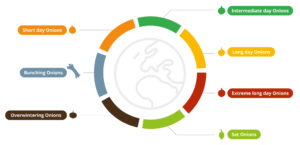Hazera’s onions: High Yield, Long Storage. The Golden Combination!
Hazera’s onions portfolio is the result of years of intensive research and development activities, combined with the knowledge and needs gained from our partners in the industry. Our high quality portfolio enables us to offer attractive, high performance varieties that can deliver success in all production processes as well as meeting consumer needs.
Hazera’s onions
Our onion portfolio consists out of yellow, red, pink and white varieties across the crop-type segments of short day, intermediate day, long day and extreme long day, as well as overwintering, set and bunching onions.

Short day onions
A short day onion variety requires a minimal 10 hours of day length (light) before the bulb formation begins. More than 13 hours of day length will limit the growth of the canopy, which is needed for creating a good size onion with optimal storing qualities.
Intermediate day onions
This crop-type requires approximately 12 to 14 hours of day length before bulb formation begins. Intermediate day onion varieties are grown in the latitudes of 35 to 42 degrees. Some of these onion varieties are produced to be stored, shipped or transported over long distances and timescales, so storability, firmness and skin retention is a key aspect in our breeding activities.
Long day onions
Long day onion varieties will start bulb formation when they receive around 14 hours of day length. Long day onions are generally suitable for longer term storage of 5 months or more. Long day onion varieties are grown for several purposes, including export and long storability.
Extreme long day onions
A day length of 16 hours or more is required to begin bulb formation in extreme long day onion varieties,which are also known as Rijnsburger types. These onions are firm, have a strong skin retention and a high level of dormancy.
Set onions
Set onions are utilized within production programmes for several reasons. In some areas where they face difficult early season conditions and temperatures, they use sets to achieve a better emergence and secure higher early yields. In other areas, early set onions are considered to be “new” fresh onions.
Overwintering onions
Overwintering onions are being utilized to help start the harvesting of onions as early as possible and supply the market with “new” fresh onions.
Bunching onions
The true bunching onion varieties generally come from a different species than the Allium Cepa, known as Allium Fistulosum and are used for bunched onions or spring onions. Varieties from this crop-type are bulbless and have long edible hollow stems and leaves.
Read more about our global focus and development programs:
High quality and high yield, the golden combination for Hazera onions – Global


